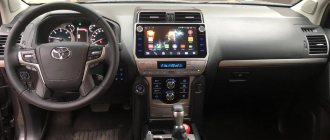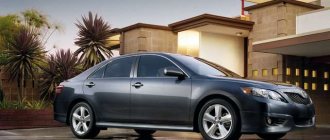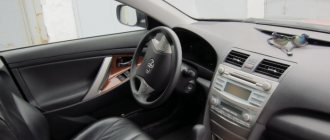The installation of gas equipment (gas equipment) on a Toyota Camry is constantly discussed by motorists with ambiguous meanings and conclusions, because on the one hand, the lower price of gas fuel provides significant financial savings, and on the other hand, running the engine on fuel unusual for it can lead to failure unit. Therefore, before such a serious modernization, it is worth considering the reasons for the controversy and weighing the pros and cons.
- Gas refers to fuel with an octane number of more than 100, which on the one hand is good, because the engine receives more “power”, and on the other – increased heat transfer and “drying” of the working volume.
- Gas fuel burns longer, which also leads to burnout of valves and catalyst without significant adjustment of the engine operating mode.
- Toyota Camry cars after 2009 with a 2.4 liter engine and a V40 body do not have hydraulic compensators, which, without the correct selection of gas equipment and precise tuning, leads to rapid failure of the power unit. By the way, it is for this reason that you can often find advice not to buy a car with gas already installed.
- Despite the fact that the latest generations of Camry in V60 bodies with 2.5 and 3.5 liter engines have been significantly upgraded in terms of fuel consumption, the cars have retained their gluttony, especially with an aggressive driving style. It is the fuel consumption factor that becomes the reason for installing gas-cylinder equipment, because its cost, even in the most “luxurious” configuration, is significantly less than the resulting fuel savings after a couple of months.
- It is worth considering that Camrys are equipped with automatic and manual transmissions, which do not give the same savings results. So, in practice, manual transmission, according to reviews from car owners, turns out to be more economical than automatic transmission; moreover, it is always worth taking into account the quality of the fuel being filled, which is clearly noticeable with an automatic transmission.
- Installing gas on a Camry cannot be done independently in a garage, because... HBO requires mandatory registration and precise adjustment, which is impossible without a professional approach, equipment and technology.
Attention! To be fair, you should pay close attention to fuel consumption when switching to gas: relative to gasoline, the engine loses some throttle response, which is reflected in an increase in consumption, especially in the city, by 15-20%. But professionals say that fine-tuning the multi-fuel mode compensates for the drop in power with a slight increase in fuel consumption. A large number of reviews on the Internet with tests on acceleration time taking into account fuel consumption are more evidence of the professional installation of LPG and the excellent technical condition of the car.
Benefits from installing HBO on Camry 40
The payback period for installing gas equipment consists of several main factors:
- cost of gas equipment elements;
- saving on fuel;
- installation cost;
- service life of the engine and gas equipment.
The approximate cost of gas equipment elements is given in the table below.
| Name | Cost, rubles | Note |
| Gearbox | 500 — 4000 | Tomasetto, Shark 1500, BRC Gemius MB 1200 |
| Control block | 4000-12000 | Stag 200, LPGTECH One, Q-Box+, Zenit Pro, Alex 48, Optima Nano |
| Injectors | 400-1600 | Valtek, Tech Yeti, Barracuda, Hana, BRC alba, BRC max |
| Balloon | 1000-4000 | Toroidal or cylindrical |
| Decorating the balloon | 2000-5000 | At the request of the car owner |
| Multivalve | 3000-6000 | Tomasetto |
| Gas level sensor | 500 — 1500 | Often included |
| Refilling device | up to 2000 | In the gas filler flap or under the bumper |
Taking into account installation, the cost of gas equipment ranges from 350 to 900 euros.
Savings on fuel after installing LPG are significant. It depends on where the driver lives and the cost of different types of fuel. Please note that gas consumption is approximately 15% higher. On average, for a year of operation, subject to a mileage of 20-25 thousand km, it is possible to spend 75-90 thousand rubles less on fuel.
Topic: What is your consumption? Review of HBO
- I have a Camry 2010, it has a 4th generation gas system installed. Consumption on board.
The computer shows when and how, on average 14-16 l/100 km. In fact, my gas consumption is about 19-21 l/100 km. I don’t understand whether this is normal gas consumption or not? I went to the company that installs gas for diagnostics, they said everything was fine. In fact, the car drives much worse on gas than on gasoline, you can really feel it.The cost of gas is 26 rubles, plus the cost of the equipment itself, plus the inconvenience of a spare wheel in the trunk. In my opinion, at the moment it is inappropriate to install gas on a car of this class
Who thinks about this? And what could be causing the high fuel consumption?
- If the car does not run on LPG after being diagnosed by specialists, then this is a clear reason to go to other specialists... When I bought the car, it also ran on LPG compared to gasoline, as it turned out later: a gearbox and injectors for the car were installed, with engine up to 2 liters (obvious redneckness of the previous owner)... Now after installing the correct equipment, the car drives the same on both types of fuel, according to the computer the consumption is 11.4 liters, in fact 13 liters, but I drive most of the time on the highway without putting pressure on the engine .. Regarding the meaning of installing an LPG: our gas costs on average 16 UAH, and 95th gasoline 33 UAH, my mileage is on average 50 t.km. per year, so consider whether it is profitable or not.
- Message from Georgy Odessa If the car does not run on LPG after diagnostics by specialists, then this is a clear reason to go to other specialists.. When I bought the car, it also ran on LPG compared to gasoline, as it turned out later: a gearbox and injectors were installed for a car with an engine of up to 2 liters (obvious redneckness of the previous owner)... Now, after installing the correct equipment, the car drives the same on both types of fuel, according to the computer the consumption is 11.4 liters, in fact 13 liters, but I drive most of the time on the highway without putting pressure on the engine.. Regarding the point of installing an LPG: here gas costs on average 16 UAH, and 95th gasoline costs 33 UAH, my mileage is on average 50 t.km.
per year, so consider whether it is profitable or not. I went to two specialists (a company and a private owner), both did not say anything about the equipment, as I understood everything was fine with it. Our gas costs 26 rubles, gasoline 41 rubles. Mileage per year is about 30,000 km. Yes, gas pays off over time. But there are a lot of problems with it in my opinion... I don’t understand how you get such low consumption. Tell me specific figures for consumption on the highway and in the city, and what kind of car do you have? - Camry 3.5 in the city 18 liters of gas on the highway 11-12 liters zenit pro installation
- I have a lunar rover, it’s written in my profile... I ride twice a day for 80 km.
one way, of which 40 km. highway, 25 km country road where the speed is no more than 50 km/h. and 15 km. city without much traffic jams. On the highway I usually travel an average of 120 km. per hour, without sharp maneuvers and without meaningful show-offs, now the engine is running in, so I try not to drive more than 90 km/h, but the consumption remains the same . s., HANA injectors and the most important thing is: NOT MANUAL SETUP OF ALL EQUIPMENT... - v 40 2.4 LPG installed in 2014 by Digitronic 4th generation, since then I have driven 100 thousand km, instead of a 55 liter spare tire the tank is filled with 50 liters of gas plus or minus 2 liters, I drive 400 km at the gas station plus or minus 20 km, the computer usually shows 10 .5 plus or minus 0.2, if I travel far 1000 km (to the South) in a day it drops to 9.5. I live in a village, no cameras, driving style is like a Camry
- Message from NIKITINAL v 40 2.4 LPG installed in 2014 by Digitronic 4th generation, since then I have driven 100 thousand km, instead of a 55 liter spare tire the tank is filled with 50 liters of gas plus or minus 2 liters, I drive 400 km at the gas station plus or minus 20 km, the computer usually shows 10 .5 plus or minus 0.2, if I travel far 1000 km (to the South) in a day it drops to 9.5. I live in a village, no cameras, driving style is like a Camry. Similar equipment, only I live in the city center. A full tank lasts +- 250 km Message from Georgy Odessa I have a lunar rover, it’s written in my profile... I ride twice a day for 80 km. one way, of which 40 km. highway, 25 km country road where the speed is no more than 50 km/h. and 15 km. city without much traffic jams. On the highway I usually travel an average of 120 km. per hour, without sudden maneuvers and without meaningful show-offs, now the engine is running in, so I try not to drive more than 90 km/h, but the consumption remains the same..
HBO costs the following: STAG 3000+ ecu, ZAVOLI gearbox for a 340 hp engine, HANA injectors and the most important thing is: NOT MANUAL SETUP OF ALL EQUIPMENT...On the highway my consumption is about 9.5-11 (depending on the speed and the number of passengers in the cabin). Apparently this is the true consumption of a car on gas. Yes, I blame the gearbox, I admit that it costs a weak engine. And because of It's worth the hassle-free setup, although the technicians assure that everything is clear. Message from 1382 Camry 3.5 in the city 18 liters of gas on the highway 11-12 liters zenit pro installation Well, I have a 2.4 engine, consumption + is the same. And in the city it turns out that the gas tank is enough for exactly 300 km?
- 2.4 eats like 3.5 has long been known!! It’s just easier for 3.5 to pull such a barge...
- If the gearbox has a weak throughput, then it will not pull under sudden loads, but if you don’t push the motor and it just doesn’t move, then it’s most likely the injectors are weak, and with such a kit you can burn the valves.
- Message from Georgy Odessa If the gearbox has a weak throughput, then it will not pull under sudden loads, but if you don’t push the motor and it barely moves, then it’s most likely the injectors are weak, with such a kit you can burn the valves. They removed the injectors, bored them out, and said that they would increase the throughput. Well, I want to say that after this operation the car began to drive noticeably better. But still, with the same position of the gas pedal, the car drives differently on gasoline and on gas. Although now this is the difference minimal compared to what it was.
Source: https://toyotacamry.ru/showthread.php?t=17425
Risks from installing gas equipment
The engines installed on the Toyota Camry 40 are not particularly suitable for operation on gas. This introduces a number of difficulties for installing LPG. The main problem is adjusting the valves with pushrods. Many installers recommend using a UOZ variator. Only precise tuning and use of HBO with OBD correction will allow you to avoid major repairs earlier.
Reviews from Camry 40 owners who switched to gas indicate the following identified shortcomings:
- valves burn out, which even the fuel injection system cannot cope with;
- valve seats sag, which leads to loss of compression and subsequent negative manifestations;
- curvature of the engine head due to thermal effects.
Comparison table of various gas equipment manufacturers
The reliability of gas equipment directly depends on the manufacturer, correct installation and configuration. The most vulnerable part of the LPG are the injectors. When operating a Toyota Camry 40 on gas, the following problems are noted:
- clogged filters;
- deposits in highways;
- the appearance of sulfur layers in the injectors.
With proper installation and configuration of gas equipment, the service life of the power unit differs from operation on gasoline within the limits of error. Therefore, with due attention to gas equipment, the Camry 40 will last quite a long time.
The risk of early breakdown arises only if there are deviations in gas injection. In this case, the engine may fail after traveling 30-60 thousand kilometers. Therefore, it is not recommended to purchase a Camry 40 with an already installed gas system. As a last resort, a thorough inspection and complete diagnosis of the power plant is required.
Gas consumption for Toyota Camry 40
Gas consumption is approximately 15% more than gasoline under equal conditions and depends on:
- in what cycle the car moves;
- what engine is installed;
- what gearbox is used;
- driving style.
A summary table of gas consumption depending on various conditions is given below.
| 2.4-liter engine with 5-speed manual transmission | 2.4-liter engine with 5-speed automatic transmission | 3.5-liter with 6-speed automatic transmission | |
| Urban cycle (l/100 km) | 13.3 | 15.6 | 16.2 |
| Extra-urban cycle (l/100 km) | 7.7 | 8.9 | 8.5 |
| Combined cycle (l/100 km) | 9.7 | 11.3 | 11.1 |
The most economical car is the one with a 2.4-liter engine with a manual transmission.
Many Camry 40 car owners, after installing LPG, note that gas consumption largely depends on the refueling location. Thus, the consumption of low-quality fuel can increase consumption to 17-19 liters per 100 kilometers.
Gas consumption per 100 kilometers for a Toyota Camry – IDOIT – Useful things for humans
February 19, 2021
The article describes the experimental determination of the real consumption of liquefied gas for a Toyota Camry converted to use this type of fuel.
Toyota Camry
Gas flow determination
All actions were carried out in reality by measuring the amount of this type of fuel used when moving between populated areas.
The adopted method cannot be considered ideal, but it is quite accessible and understandable for determining this parameter.
Fuel consumption, including gas, is very important in all respects, especially when a decision is made whether or not to switch your car to this type of fuel.
Initial conditions
The trips were carried out on a hot July day; in the morning at 7:00 the outside air temperature was plus 22°C. The car is a 2012 Toyota Camry 50 with a 2.5-liter engine and a six-speed automatic transmission.
Gas filling will be carried out by the same operator until the gas nozzle is automatically fired. Driving conditions are economical, wheel size is standard, tire pressure is normal. The quality of the road surface is normal.
Conversion of Toyota Camry to gas
Based on the results of three measurements of gas consumption (three crossings in the same road conditions), the average gas consumption per 100 kilometers will be determined.
First trip
We move on gas all the time. There are three people in the car, the trunk is fully loaded. Before the trip, the gas cylinder is filled to capacity. Due to the high outside temperature, the car will always drive with the climate control always on.
At an average speed of 95 kilometers per hour, the travel time was 1 hour 45 minutes, and the distance covered was 170 kilometers. On certain sections of the highway the speed was up to 110-120 km/h, and when overtaking – 140-150.
Having arrived at the destination, we refueled the gas cylinder by “shooting” (the same as during the first refueling). It turned out that 11.6 liters of fuel fit into it. This means that this amount of it was used on this path. Dividing this figure by the kilometers traveled, we get gas consumption of 6.8 liters per hundred kilometers (11.6:1.7 = 6.8).
Trip two
The conditions have not changed, except that there are now only two people in the cabin and the trunk is almost empty. We fill up with gas and hit the road. We drive at a speed of 110 - 120 kilometers per hour with infrequent overtaking.
Gas equipment for cars Atiker Nicefast
Having traveled 440 kilometers, we again fill the cylinder with gas in a volume of 35 liters. We calculate the consumption: 35:4.40 = 8 liters of gas per 100 kilometers. Thinking about why the consumption was higher on this trip, it is assumed that at this distance there were more moments when the car was moving at a speed of 140 - 150 km/h, both when overtaking and in free areas.
Trip three
The outside temperature conditions have changed. The trip takes place at a lower air temperature, so climate control is not used while driving. The speed limit has been slightly increased - traffic prevails at a speed of 120 kilometers per hour or more.
At the destination, we fill up with gas until the tank is full - the amount of gas is 8.8 liters. 147 kilometers covered. We calculate the consumption: 8.8:1.47 = 6 liters of fuel per hundred kilometers.
What's the result?
We calculate the average gas consumption for all three trips: (6.3 +8.0 +6.0):3 = 6.8 liters of fuel per 100 kilometers. In round numbers we take 7 liters, which is quite a decent result in terms of saving money on fuel if you use gas instead of gasoline.
Sergey Morozov
Attention! This article is protected by the Digital Millennium Copyright Act (DMCA). Any copying without my permission is prohibited.
Source: https://idoit.ru/2018/02/19/rashod-gaza-na-100-kilometrov-avtomobilem-toyota-camry/
Installation recommendations
Most Camry 40 car owners with LPG focus on the importance of a filter with a sump in front of the injectors. Clogging of injectors not only leads to a decrease in dynamics, but can also cause damage to the power unit. It is extremely important to promptly change the filter every 10-20 thousand kilometers.
Recommended filter for installation
Installation of the cylinder is possible both with and without decor. The first option allows you to disguise the HBO in the trunk. In the second case, you will be able to save about 2,000 rubles on installing gas equipment.
Balloon without decoration
Balloon with decoration
Review of HBO installed on Toyota Camry 40
There are two types of cylinders:
- toroidal, installed instead of a spare wheel;
- cylindrical, placed in the trunk.
Multivalve includes:
- shut-off electric valve;
- fire valve;
- electronic fuel level sensor.
HBO takes up virtually no space in the engine compartment.
General view of the engine compartment
The photo below shows an example of the layout of BRC Sequent gas equipment.
Engine compartment arrangement of gas equipment
The switch button and the operating mode indicator for gas equipment are located in the cabin. The most optimal place is considered to be installation instead of the plug located to the left of the steering wheel.
It is recommended that the external filling device be located under the gas tank flap.
External filling device
In this case, refueling occurs using a special adapter.
VZU with adapter for filling nozzle
Call and you will receive:
- — Professional installation of LPG from well-known European manufacturers for Toyota Camry cars
- — Warranty and post-warranty support of installed gas equipment
- — Qualified service using original consumables
- — We have the best prices on the market , we have been working since 1997!
- — We dropped off the car in the morning and picked it up in the evening!
- — We’ll tell you which one is better to install a cylinder on a Toyota Camry
- — 3 years warranty for Toyota Camry, unlimited mileage
- — Still have questions? An experienced master will answer you by phone +7(499)372-0320, call!
| Registration of HBO with the traffic police for a Toyota Camry: |
In our service center, you will be able to register the LPG for a Toyota Camry with the traffic police according to a simplified scenario - we will do all the necessary expertise for you
. Moreover, we can do all the registration for you - call us and we’ll arrange it. LPG registration began to be requested in 2021, this is especially important for those who have components of gas equipment in plain sight, but for Toyota Camry we also recommend doing this. Read more about the procedure for registering HBO with the traffic police, who came up with it, why it is needed and whether it is necessary at all.










